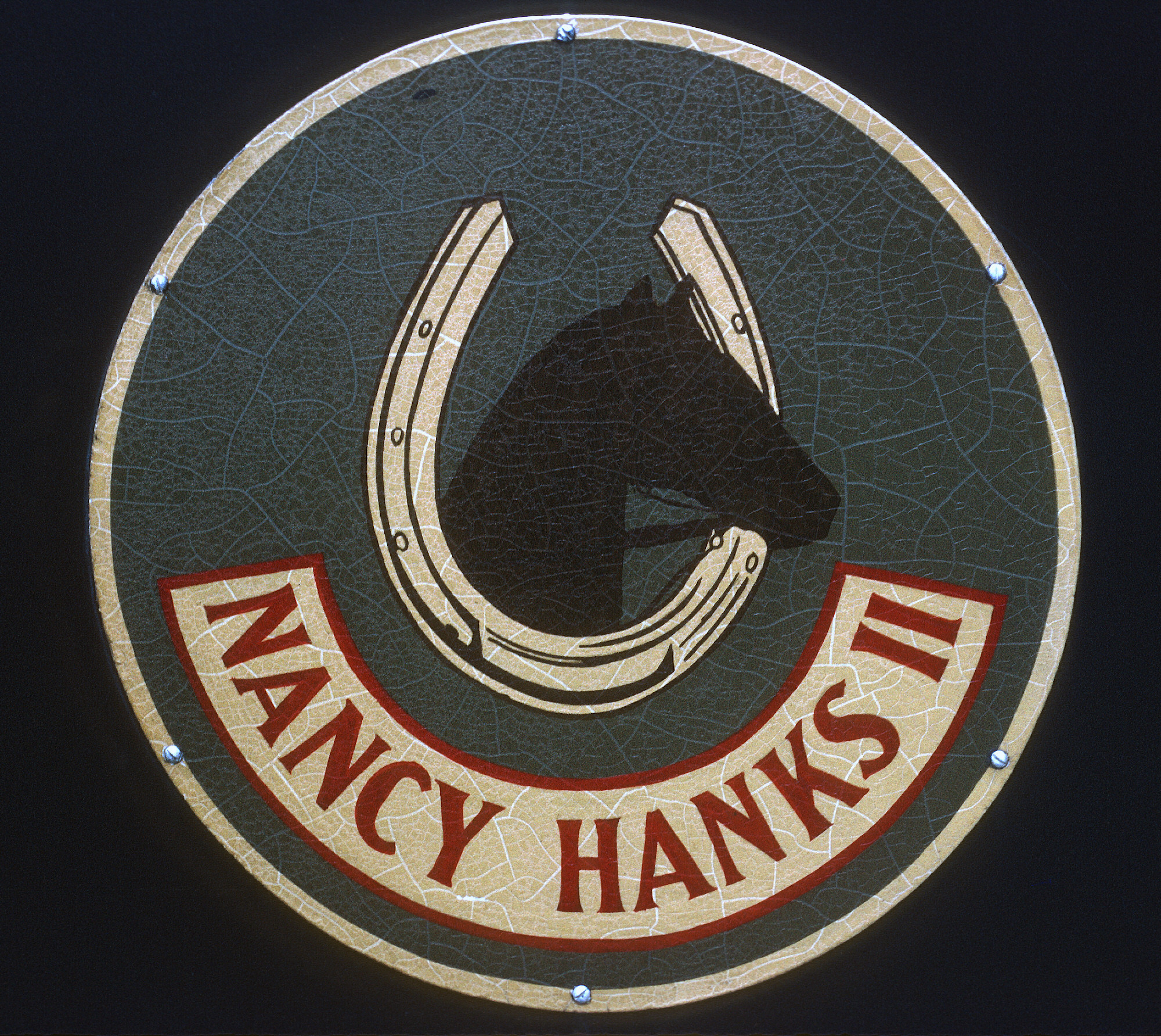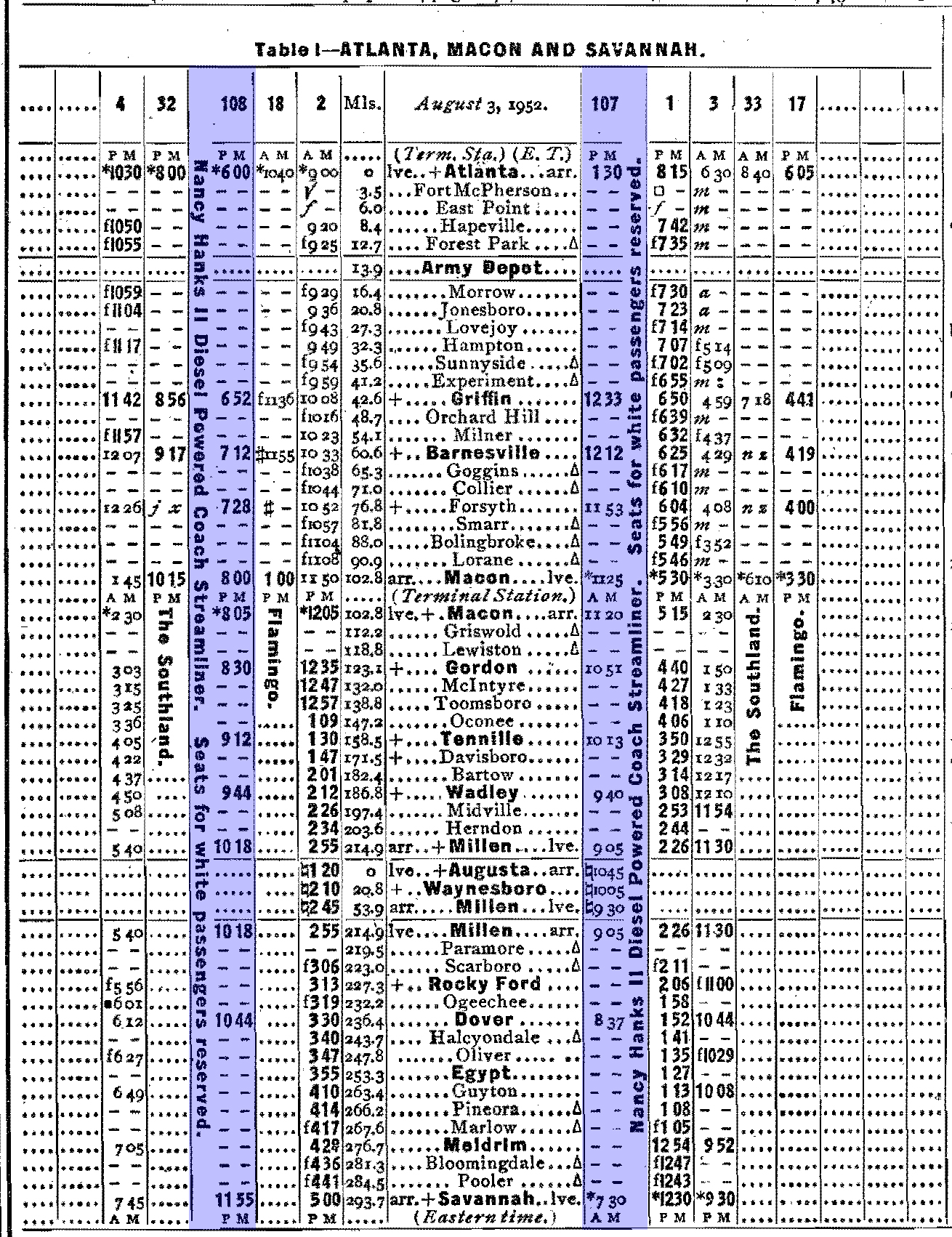"Nancy Hanks II" (Train): Consist, Route, Timetable
Last revised: February 24, 2025
By: Adam Burns
The Nancy Hanks II was a popular streamliner operated by the Central of Georgia Railway (CofG). Named after a famous racehorse, the train began its celebrated run in the wake of America's post-World War II railroad renaissance.
The original Nancy Hanks first made headlines as a prominent Southern passenger service in the late 19th century. However, the II moniker reflected a renewed dedication to luxury and modernity that crystallized in the mid-20th century.
Launched on July 17, 1947, the Nancy Hanks II embodied the era's fascination with speed and style. Streamlined and elegant, it signified the railway's commitment to a first-class travel experience.
The route stretched between Savannah and Atlanta, Georgia, covering roughly 294 miles. Riders were treated to scenic vistas of Georgia's stunning landscapes, from bustling urban centers to serene countryside.
With a 6-hour schedule designed for convenience, the train facilitated robust morning departures and evening arrivals, making it an optimal choice for both business and leisure travel.
Equipped with state-of-the-art amenities, the Nancy Hanks II offered "De Luxe" coaches with reclining seats, a grille lounge "serving all meals and refreshments," and porter/maid service. .
Despite its initial success, the Nancy Hanks II faced challenges as the 20th century progressed. The rise of automobile travel and the burgeoning airline industry began to siphon off its passenger base. By the 1960s, even though it remained a beloved service for many, financial viability became a pressing concern.
Ultimately, the Nancy Hanks II made its last run on April 30, 1971, marking the end of an era. The train's legacy, however, continues to resonate. It stands as a testament to the golden age of rail travel, evoking an epoch where the journey was as significant as the destination.
The Nancy Hanks was a beloved passenger train operated by the Central of Georgia Railway (later Southern Railway after 1963) that whisked passengers between Atlanta and Savannah, Georgia.
Its name honored a celebrated racehorse, which itself was named after Abraham Lincoln's mother. This storied train traces its origins even further back to an earlier steam special, also named Nancy Hanks, which operated briefly in 1892 and 1893.
Timetable (1952)
Inauguration
With the streamliner craze sweeping the nation throughout the 1940s the 1,800-mile Central of Georgia was quick to jump on board after the war - in addition to already providing through services for long distance trains like the City of Miami.
In 1947 it launched two of its own; the Nancy Hanks II and Man O' War, both named after famous race horses. In their book, "Streamliners: History Of A Railroad Icon," authors Joe Welsh and Mike Schafer note American Car & Foundry built a 10-car set for the Nancy which included one baggage-coach combine, four regular coaches, four "divided" (segregated) coaches, and one grill lounge.
The companion Man O' War (the 117 mile Atlanta - Columbus corridor) featured a 4-car trainset from the Budd Company that included combine Fort Mitchell, coaches Fort McPherson and Fort Oglethorpe, and club-observation Fort Benning. Both trains were led by streamlined E7s.
The Nancy Hanks II entered service on July 17, 1947. Distinguished by its striking blue and gray cars, the train quickly garnered affection and admiration. Riders fondly referred to it as "The Nancy."
The train carried an averaged a speed of 48 mph, including stops, making the 293.7-mile journey in approximately six hours.
The daily schedule saw it depart from the Central of Georgia Depot in Savannah at 7 a.m., traverse to Atlanta via Macon Terminal Station, and return from Atlanta at 6 p.m. sharp.
In addition, the CoG provided a connecting service between Millen and Augusta known as the Little Nancy. However, as patronage declined during the 1950s this connector was dropped.
In the 1960s, an especially luxurious touch was added: a dome parlor-lounge car leased from the Norfolk & Western/Wabash. Built by Pullman-Standard, the 85-foot steel car featured dark blue exteriors and interiors upholstered in royal blue and gray. Befitting its racehorse theme, the lounge beneath the dome was charmingly branded as the "Saddle & Stirrup."
Central of Georgia Railway
The Central of Georgia Railway is an emblematic story. Founded in 1833 as the Central Rail Road and Canal Company, it was initially conceived to address the transportation needs of Georgia's burgeoning cotton industry.
With Savannah as its eastern terminus, the railway sought to connect to the fertile farmlands of Georgia's interior to expedite the transport of cotton to the port city for shipment.
Construction officially commenced in 1836, and by 1843, the line had successfully stretched from Savannah to Macon, a pivotal junction in Middle Georgia. This 190-mile route marked the beginning of CofG's extensive network.
At its peak the CoG operated a network of 1,815 miles connecting Atlanta, Savannah, Montgomery, Birmingham, and Chattanooga.
In 1951, the Illinois Central acquired a controlling interest in the Central of Georgia, infusing it with new management practices and capital. Yet, even with this support, the changing transportation landscape proved difficult to navigate.
By the mid-1960s, as part of a broader trend of consolidation in the American railroad industry, CofG sought stability through mergers. In 1963, it came under the control of the Southern Railway, a move formalized in the early 1970s.
The legacy of the Central of Georgia endures, with many of its routes still active under the auspices of Norfolk Southern, which absorbed Southern Railway in the 1980s.
Its story reflects the broader economic and technological shifts of the 19th and 20th centuries and remains a testament to the pivotal role railroads played in shaping the United States.
Today, preserved locomotives, passenger cars, and detailed records keep the history of the CoG alive for historians and rail enthusiasts, serving as poignant reminders of a transformative era in American transportation.
 The Nancy Hanks II nameplate adorned on a coach at coach at Bluefield, West Virginia along the Norfolk & Western on September 19, 1970. Roger Puta photo.
The Nancy Hanks II nameplate adorned on a coach at coach at Bluefield, West Virginia along the Norfolk & Western on September 19, 1970. Roger Puta photo.Final Years
Despite its charm and regional popularity, the Nancy Hanks II could not escape the larger trend of declining rail service in the 1960s. Ridership dwindled, and although Southern Railway chose to remain in the passenger business when Amtrak took over most passenger services, the Nancy Hanks II did not make the cut.
Consequently, it made its final run on April 30, 1971, just one day before Amtrak's inception. Atlanta's Terminal Station, a central part of its history, was demolished the following year.
The legacy of the Nancy Hanks II endures, remembered nostalgically as a symbol of the golden era of rail travel, offering an experience where the journey itself was imbued with elegance and splendor.
Recent Articles
-
Florida Railroad Museums: A Complete Guide
Apr 17, 25 04:48 PM
Florida is home to many railroad museums preserving the state's rail heritage, including an organization detailing the great Overseas Railroad. -
Delaware Railroad Museums: A Complete Guide
Apr 17, 25 04:23 PM
Delaware may rank 49th in state size but has a long history with trains. Today, a few museums dot the region. -
Arizona Railroad Museums: A Complete Guide
Apr 16, 25 01:17 PM
Learn about Arizona's rich history with railroads at one of several museums scattered throughout the state. More information about these organizations may be found here.
![89712361274318798125908267].jpg 89712361274318798125908267].jpg](https://www.american-rails.com/images/129378412616235762134892359802309690276.jpg)

